► Limited edition A110R 70 revealed
► Marks the end of petrol production
► Tricolour variant even more exclusive
The Alpine brand is 70 years old in 2025, and to celebrate it’s launching the A110R 70 – a limited edition of 770 cars that will also mark the end of Alpine A110R production. In fact, it’s the end-of-the-line for the current A110 entirely this year, and there are changes to the regular range to reflect this as well.
Chief among these is the addition of a new A110 GTS model that appears to offer much of the A110R’s performance and appearance at a significantly lower cost. There is also much mucking about with paint colours.
All planned fanfare ahead of the all-electric Alpine A110 that’s coming to replace this outgoing petrol model in 2026.
What’s special about the Alpine A110R 70?
Alpine’s 70th birthday present to itself is mostly about carbonfibre. The wonder-weave is used for the front bonnet, the roof, the rear window – meaning it’s more of a slotted panel – and the rear wing. The 18-inch carbonfibre rear wheels probably have the most dramatic impact on the way the A110R drives, given the reduction in unsprung weight.
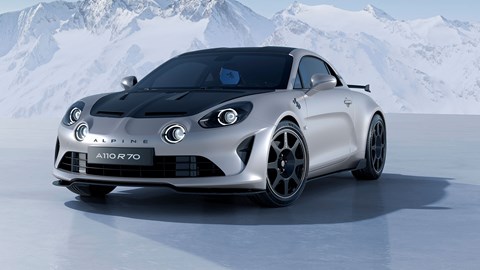
There are no chassis changes or power upgrades over the regular A110R (which is detailed further down this page), which was already the most focused variant in the range. This means 296bhp and 250lb ft, greeting the surrounding hordes via an Akrapovic exhaust. Michelin PS Cup 2 tyres are fitted as standard, and you can choose from seven different colours for the Brembo brake calipers.
Speaking of colours, there are 10 body colours for the A110R, plus 70th anniversary logos on the wheelarches, door sills and headrests, as well as a few strategically positioned French flags. Four different interior design schemes are available, too.
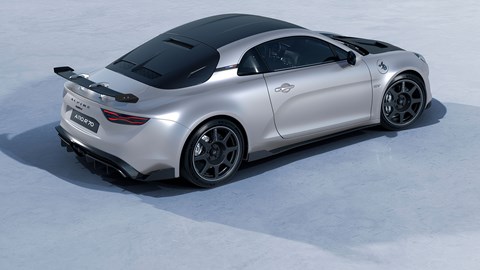
Then there’s the special Tricolour edition of this special edition…
What’s the A110R 70 Tricolour Edition?
Nested within the 770 examples of the A110R 70 available are three further limited allocations that make up an even more exclusive Tricolour edition – 70 of each finished in Blue Caddy, Glacier Blanc and Rouge Sismique. These cars not only echo the colours of the French flag, they also pay tribute to the three Alpine A106s that officially marked the creation of the Alpine brand in 1955.
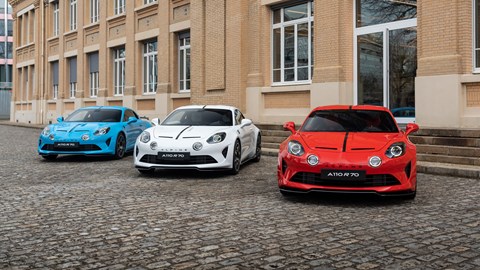
The A110R 70s have the 70th anniversary logo marked out in visible carbonfibre on the roof. But they’re also fully colour-coordinated – meaning the stripe on the 18-inch carbonfibre wheels and the new Sabelt upholstery in the cabin match the chosen paint.
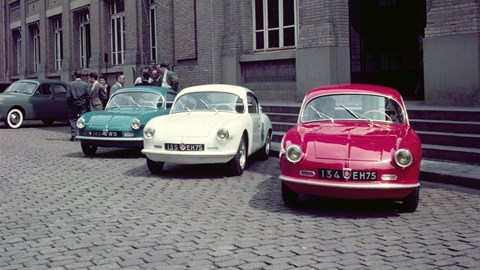
How much?
The new Alpine A110R 70 is priced from £103,345, and should be available to order from March 2025.
So, about the ‘standard’ version of the A110R…
The Alpine A110R might be the ultimate expression of the Dieppe-built sports car, or the one that strays furthest from the brilliant original A110’s DNA, it depends on your view.
Lighter, firmer and faster than the A110S, the track-focussed if still road-legal R mirrors the positioning of the Porsche Cayman GT4, making it an entirely logical piece of the product-planning jigsaw. It also inevitably moves the R even further away from the supple-limbed agility of the original A110 than the imperfect S.
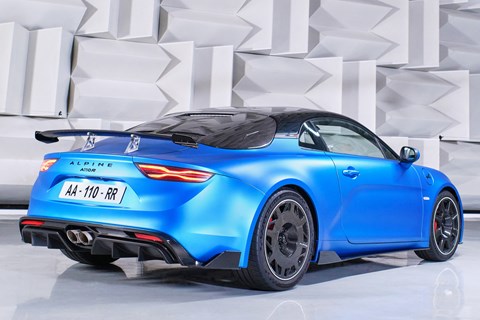
Weight falls just 34kg, there are modest aerodynamic gains and performance from the 1.8-litre turbo four is unchanged from the S’s 296bhp, yet the many detail changes together with bigger steps in several areas do suggest a quite different and potentially highly enticing driving experience.
CAR spent a day at Alpine HQ with several engineers and senior personnel to learn more…
Couldn’t they have made it lighter?
While a 34kg weight saving does sound underwhelming, it’s important to remember that the A110 starts from a baseline some 300kg or so lighter than any competitor, so the R’s engineers are chasing diminishing returns. And the weight-saving measures are quite comprehensive.
Lotus Emira vs Alpine A110 S vs Porsche Cayman GTS
Full carbonfibre wheels produced by Duqueine account for most of the reduction at 12.5kg – the front wheels feature a more open face to promote better brake cooling, while the rears are more closed to reduce drag. There’s carbonfibre for the bonnet, roof and rear window/engine lid, the latter necessitating a digital rear-view mirror because there’s no view over your shoulder, just like a Ferrari 812 Competizione.
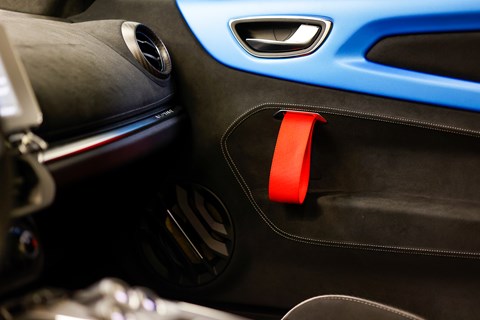
Inside, there’s racey microfibre trim, straps for door handles, six-point harnesses and full carbonfibre Sabelt seats that save 5kg. One kilo was saved removing the active exhaust flap. Overall weight drops to 1082kg.
Why doesn’t the R have more power than an A110S?
A modest power increase is certainly the norm in this niche, but when CAR raised the issue, Alpine programme director Xavier Sommer replied : ‘We are not in an arms race, and power has a bad impact on weight, cost, cooling, brakes… In a world of CO2, even with this kind of car it’s more and more important, people are more aware to have a good power-to-weight ratio and I think our message will be increasingly successful.’
Hence the powertrain is lifted straight from the S – a 1.8-litre turbo four with 296bhp and 251lb ft that’s mated to a seven-speed dual-clutch gearbox, though there is a new 3D-printed double-wall exhaust outlet. Acceleration figures change too, with 0-62mph falling to 3.9sec (a 0.3sec improvement over the S), and top speed climbs to 177mph thanks to aerodynamic upgrades (up 7mph over the optional aero-kitted S).
What are the aerodynamic changes?
Alpine says aerodynamics have been improved with help from its Alpine F1 team in the wind tunnel, with key features including a ‘swan-neck’ rear spoiler, additional intakes in the front apron and a new, wider rear diffuser. Downforce increases 27kg at the rear, and while we were initially told downforce decreases by 30kg at the front, revised figures state a 14kg increase for the front compared with an A110S equipped with the optional aero kit.
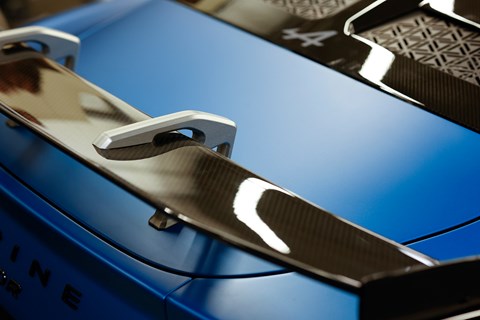
There’s also a flat underbody combined with new sideskirts to promote smooth airflow under the car, contributing towards a 5 per cent reduction in drag (with the rear spoiler in its ‘track attitude’ setting).
Talk me through the chassis upgrades…
This should be the most palpable difference between the A110R and other Alpines, especially at the typical road speeds where the full aerodynamic improvements won’t be felt. Compared with the A110S, spring stiffness increases 10 per cent all-round, anti-roll bar stiffness is up 10 per cent front, 25 per cent rear, and new ZF dampers are adjustable for compression and rebound via 20 clicks.
The R is 10mm lower than an S as standard, but the suspension can be lowered a further 10mm – though Alpine stresses this setting is only suitable for track work, where it will no doubt prove particularly transformative, especially in terms of managing weight transfer at higher speeds.
Crucially, the entire set-up has been tuned on a bespoke compound of semi-slick Michelin Cup 2 R tyre. Sizes of 215/40 R18 front and 245/40 R18 at the rear are unchanged from the A110S, which also offers the Cup 2 as an option.
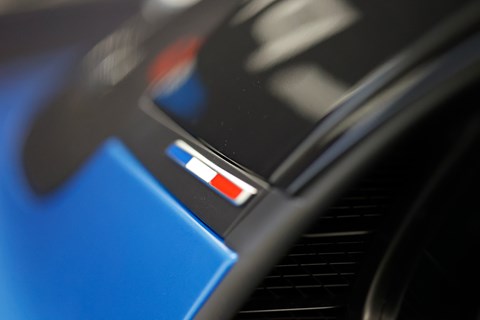
Brembo brakes with 320mm discs front and rear are standard – another option for the S – but the R has improved cooling thanks to new ducting on the upper front suspension arms and undertray.
‘We tested at Circuit de Charade, Magny Cours and Nardo,’ test driver David Praschl told CAR. ‘We want to keep the A110 feeling and balance, but with better body control. You can still play with the R – there’s some understeer in faster corners, but it’s still reactive in slower corners and the handling now responds faster as you lift the throttle. The steering feels noticeably heavier [thanks to the uprated chassis] – not a lot, but you notice.’